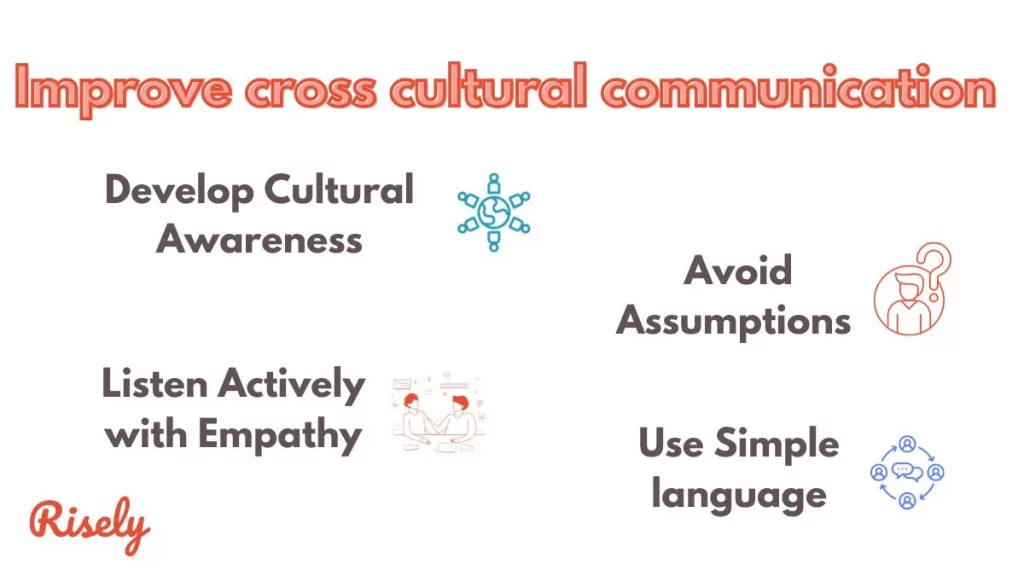Understanding Cross Cultural Communication In The Workplace: Top 5 Examples
Effective communication is the most valuable skill to foster a collaborative work environment. As the team becomes more diverse, it is essential to establish effective cross cultural communication for success. As per Fierce’s survey, 86% of employees feel ineffective communication is the primary factor for workplace failures. In this blog post, we will dive into what cross cultural communication is and why it is important in the workplace. We will also explore some examples of cross cultural communication in the workplace. Additionally, we will discuss some factors affecting cross cultural communication in the workplace and strategies for improving it. By the end of this blog post, you’ll better understand how to communicate effectively with people from diverse cultures in your workplace. Let’s dive in!- Understanding Cross Cultural Communication In The Workplace: Top 5 Examples
- What is Cross cultural Communication in the Workplace?
- Importance of Cross cultural Communication in Workplace
- Benefits of Effective Cross cultural Communication
- Factors Affecting Cross cultural Communication in the Workplace
- Strategies for Improving Cross cultural Communication in the Workplace
- Examples of Cross cultural Communication in the Workplace
- Conclusion
- FAQs
- Other Related Blogs
What is Cross cultural Communication in the Workplace?
Effective communication is essential for a productive and harmonious work environment, but it can be challenging when individuals come from different cultural backgrounds; there comes the role of cross cultural communication in the workplace. Cross cultural communication in the workplace is exchanging information between people from diverse cultures to establish understanding and respect. However, misunderstandings can lead to a loss of productivity, decreased morale, and damaged relationships. Therefore, it is crucial to implement strategies that promote effective communication among co-workers with varying cultural backgrounds. Check out “The Dangers Of Misinformation In The Workplace: How Managers Can Address It?“Importance of Cross cultural Communication in Workplace
Cross cultural communication is essential for promoting understanding and respect for diverse cultures in the workplace. When colleagues from diverse backgrounds work together, there is an opportunity to learn from each other and leverage unique perspectives, leading to better teamwork, creativity, and productivity. On the other hand, miscommunication due to cultural differences can lead to conflicts and misunderstandings that can negatively impact collaboration. Therefore, developing strategies that promote effective communication among colleagues from different cultures is crucial. This includes active listening, avoiding assumptions and stereotyping, learning about different cultures, and using simple language everyone can understand. By prioritizing cross cultural communication in the workplace, organizations can create a more inclusive environment where everyone feels valued and respected.Benefits of Effective Cross cultural Communication
Cross cultural communication in the workplace brings numerous benefits. Here are some key advantages:- Increased Cultural Awareness: Effective cross cultural communication promotes cultural awareness and understanding among employees. It exposes individuals to different perspectives, values, and beliefs, fostering a sense of appreciation for diversity. This cultural awareness helps break down stereotypes, reduces bias, and promotes inclusivity.
- Enhanced Collaboration and Teamwork: When employees from diverse cultural backgrounds communicate effectively, they can collaborate more efficiently. Different cultural perspectives bring a wealth of ideas, insights, and approaches to problem-solving. This diversity in teams of thought enhances creativity, innovation, and teamwork, improving outcomes and productivity.
- Expanded Market Reach: In today’s globalized business environment, organizations that engage in cross cultural communication gain a competitive edge. They can effectively connect with and understand customers from different cultures, enabling them to tailor their products, services, and marketing strategies to specific target markets. This expands their market reach and increases their chances of success in international business ventures.
- Reduced Misunderstandings and Conflicts: By promoting cross cultural communication, organizations can minimize misunderstandings, misinterpretations, and conflicts in the workplace. Clear communication, active listening, and cultural sensitivity help prevent communication breakdowns and foster mutual understanding. This leads to improved relationships among employees and a more positive work environment.
- Enhanced Problem-Solving and Decision-Making: Cross cultural communication facilitates a broader range of perspectives and approaches to problem-solving. Employees from different cultural backgrounds bring diverse experiences and knowledge, enabling organizations to tackle complex challenges from multiple angles. This diversity of thought improves decision-making processes and increases the likelihood of finding optimal solutions.
Factors Affecting Cross cultural Communication in the Workplace
Several factors can influence communication effectiveness among diverse cultural teams. I have listed and explained some of the significant barriers to help you understand them in a better way:Language Barriers
Effective cross cultural communication can be challenging due to language barriers. Even if individuals speak the same language, cultural nuances, and idioms can create misunderstandings. Interpreters or translators can help bridge the gap but must deeply understand both cultures. Learning key phrases in the other person’s language shows respect for their culture and helps break down communication barriers. It is important to exercise patience as misunderstandings may still occur despite best efforts.Non-Verbal Communication
Non-verbal cues such as facial expressions, gestures, and body language can have different meanings across cultures. For example, eye contact, personal space, and physical touch can be interpreted differently. Therefore, awareness of these non-verbal cues and their cultural significance is crucial for effective cross cultural communication. Learn more from the Guide To Nonverbal Communication For Managers: Types & How To ImproveTime Orientation
Different cultures have different approaches to time management and punctuality. For example, some cultures prioritize punctuality and adhere strictly to schedules, while others have a more relaxed attitude toward time. These differences can lead to misunderstandings and frustrations if not properly understood and accommodated.Strategies for Improving Cross cultural Communication in the Workplace
Developing strategies for improving cross cultural communication in the workplace can significantly impact employee satisfaction, productivity, and overall success. Here are some effective approaches to promote Cross cultural Communication in the Workplace;Develop Cultural Awareness
Understanding and appreciating the differences between team members from diverse cultures is essential to developing effective cross cultural communication in the workplace. Cultural awareness involves learning about the customs, values, beliefs, and communication styles of individuals from different backgrounds. Encouraging open communication and active listening helps build trust and understanding between co-workers from different cultural backgrounds. Creating a diverse and inclusive workplace culture can lead to better collaboration, creativity, and productivity. By developing cultural awareness, managers can foster a more positive work environment conducive to effective cross cultural communication.Avoid Assumptions and Stereotyping
Assumptions and stereotyping can harm cross cultural communication, leading to misunderstandings and offense. Therefore, it’s essential to approach each interaction with an open mind and without preconceived notions. To avoid stereotyping or making assumptions about someone based on their culture, it’s crucial to be willing to ask questions and clarify any misunderstandings that may arise. Cultivating a sense of curiosity and openness can help us understand our co-workers better and foster a more inclusive workplace culture. In addition, we can build stronger relationships across cultural boundaries by avoiding assumptions and engaging in active listening.Listen Actively and with Empathy
Effective cross cultural communication requires active listening and empathy. When communicating with colleagues from diverse backgrounds, paying attention to their message without interrupting or judging is important. Active listening involves hearing what is being said and understanding and processing the information the speaker conveys. Additionally, demonstrating empathy by putting oneself in the other person’s shoes can help build trust in your team and improve communication. Respecting cultural differences and practicing open-mindedness create a more inclusive workplace that values diversity and fosters better collaboration.Use Simple Language and Avoid Slang
Clear and concise language is essential for cross cultural communication in the workplace. Using simple language easily understood by individuals from different backgrounds is crucial for effective communication. Slang terms and idioms may be unfamiliar to people who speak a different language or come from a different culture, leading to misunderstandings or confusion. Therefore, using straightforward language that avoids jargon or colloquialisms is essential. Check out “Principles of effective communication: A basic guide for better dialogue“ When communicating with individuals who are not fluent in your language, speak slowly and clearly, and use visual aids if necessary. This ensures that your message is received accurately by all team members, regardless of cultural background.
Examples of Cross cultural Communication in the Workplace
Here are five examples of cross cultural communication in the workplace:- Language and Verbal Communication: Employees may come from diverse linguistic backgrounds in a multicultural workplace. Effective cross cultural communication involves being mindful of language barriers and using clear and concise language to ensure all understand messages. Employers may also provide language training or translation services to bridge communication gaps.
- Non-Verbal Communication: Non-verbal cues such as body language, gestures, facial expressions, and personal space can vary across cultures. Awareness of these differences and correctly interpreting them is crucial for effective communication. For example, a thumbs-up gesture may be positive in some cultures but offensive in others.
- Cultural Norms and Etiquette: Each culture has its norms and etiquette regarding workplace interactions. Understanding and respecting these cultural nuances can prevent misunderstandings and foster positive relationships. For instance, some cultures value direct communication, while others prefer indirect or more formal communication styles.
- Time Management and Punctuality: The perception of time and punctuality can vary across cultures. Some cultures prioritize strict schedule adherence, while others are more flexible. Recognizing and accommodating these cultural differences can help avoid conflicts and promote effective collaboration.
- Conflict Resolution: Conflicts are inevitable in any workplace, and cross cultural communication plays a crucial role in resolving them. Different cultures may have varying approaches to conflict, such as open confrontation or avoidance. Employing culturally sensitive conflict resolution strategies, such as active listening, empathy, and compromise, can help bridge gaps and foster understanding.
Conclusion
Effective cross cultural communication in the workplace is more critical now than ever. It is essential to understand that cultural differences are not a hindrance but an opportunity to learn and grow. Cross cultural communication helps build trust, understanding, and mutual respect among employees and colleagues, leading to a harmonious work environment. By acknowledging and embracing diversity, the workplace can become a hub of creativity, innovation, and productivity. Sign up for Risely, test your communication and other managerial skills with free assessments, and learn to become a better manager, creating a healthy work environment for team members.Build robust communication skills to manage shifting team dynamics with a free assessment.
The free communication skill assessment enables managers to track all-round communication ability and spot errors.
FAQs
What is cross-cultural communication in the workplace?
Cross-cultural communication in the workplace refers to exchanging information, ideas, and messages between individuals from different cultural backgrounds within a professional setting, aiming for effective understanding and collaboration.
What are some examples of cross-cultural communication?
Examples of cross-cultural communication in the workplace include adapting communication styles to accommodate cultural differences, using interpreters or translators, promoting inclusivity, respecting diverse perspectives, and practicing active listening.
What are the 5 principles of cross-cultural communication?
The five principles of cross-cultural communication are cultural awareness, empathy, open-mindedness, adaptability, and respect. These principles help foster understanding, effective communication, and positive interactions across diverse cultural contexts.
Other Related Blogs
Executive Communication Coach: When And How To Choose
Executive Communication Coach: When And How To Choose Good communication is a must for professional success. After all, half of people management is all about saying the right things in…
Emotional Intelligence In Communication: 5 Ways Smart Leaders Act
Emotional Intelligence In Communication: 5 Elements Smart Leaders Use Effective communication is the cornerstone of a thriving workplace. It doesn’t matter if you’re speaking to your team members, clients, or…
15+ Sales Manager Best Practices to Boost Your Team’s Performance
15+ Sales Manager Best Practices to Boost Your Team’s Performance As a sales manager, you are responsible for achieving your targets and driving your team’s performance. It’s easy to get…
Communicating Employee Benefits is Essential: 5 Hacks to Do it Right
Communicating Employee Benefits is Essential: 5 Hacks to Do it Right Employee benefits are crucial in attracting, retaining, and engaging employees. However, it’s not enough to simply provide benefits; effectively…


